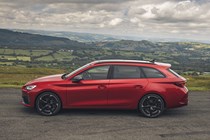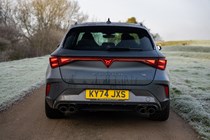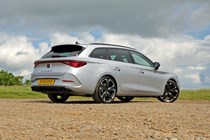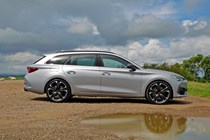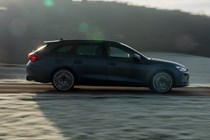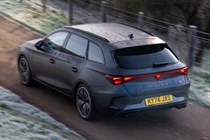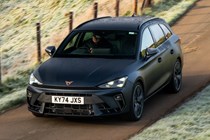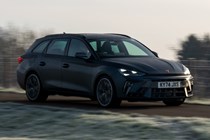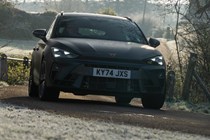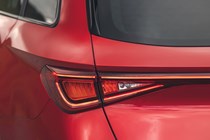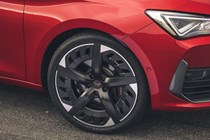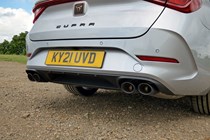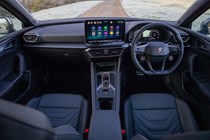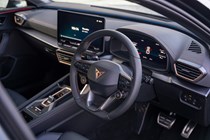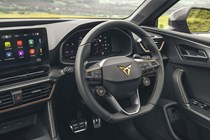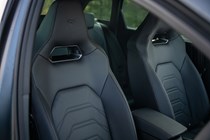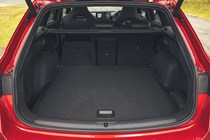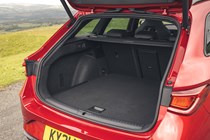
Cupra Leon Estate long-term test
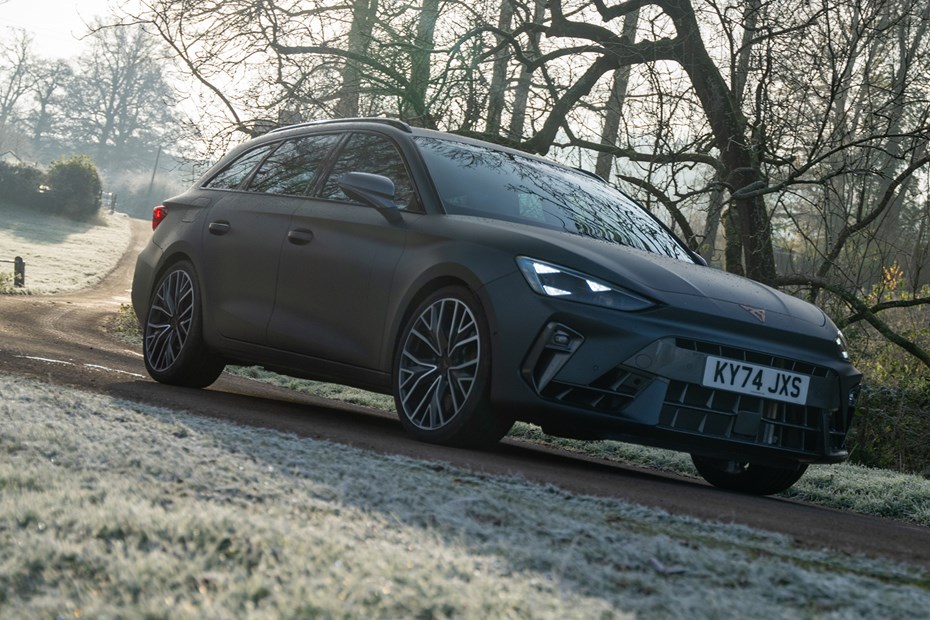
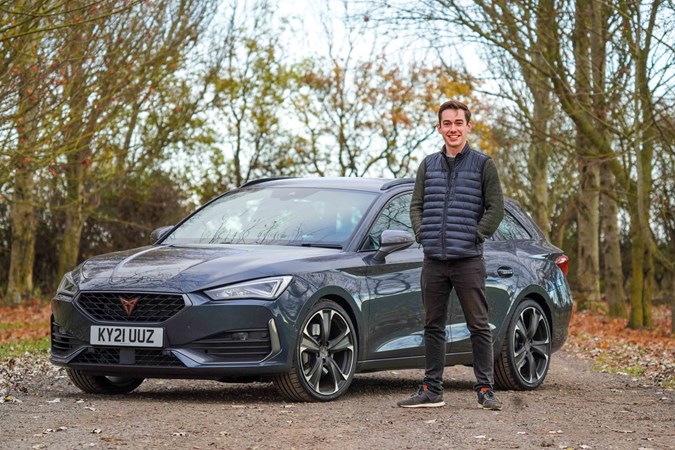
In the second half of 2021, James Dennison got his hands on a Cupra Leon Estate. Is it all the car you’ll ever need and should you buy one instead of an equivalent performance SUV? Read on to find out…
Reports by James Dennison
Jump to:
- Update 2: Practicality and space
- Update 3: How much does it cost to run a Cupra Leon Estate?
- Update 4: Verdict
Update 1: Welcome
Getting to know the latest addition to the Parkers long-term fleet.
As the VW Group delivery man drops off my new Cupra Leon Estate long-termer, I get a distinct feeling of déjà vu. After all, it was only three years ago that I was lucky enough to run this car’s predecessor for several months, and although the manufacturer has technically changed (more on that in a second), I’m already drawing the parallels.
The sharp looks, 300hp (ish) AWD powertrain, huge boot – all things you want in a car that’s supposed to be practical and fun. In fact, as the last Cupra left I remember thinking that – for many people – it’s all the car you could ever want. Since then, however, things have been complicated somewhat.
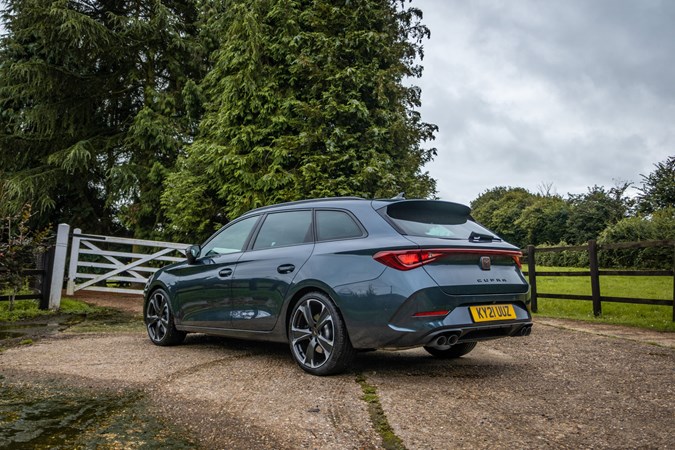
The never-ending rise of the SUV has found its way into the attainable performance car market, meaning fast estates often now have equally rapid SUV siblings. See the VW T-Roc R and Cupra Ateca as prime examples. Same power, similar chassis components and similar price. No doubt highly tempting, but was does this mean for the cars like the Cupra Leon Estate that used to have a niche all to themselves?
Well, over the next few weeks I’ll be giving you the honest verdict on life with the Cupra, including how expensive it is to run, how practical it is, how fun it is and how it stacks up against SUV rivals. But first, a proper introduction.
The spec – VZ2
Let’s start by clarifying what I meant about the manufacturer of this car. Of course, anyone can see that this is, broadly speaking, a SEAT Leon underneath. However, since 2018, Cupra has become its own separate entity and although the cars share many parts and are built in the same factory, my new long-termer is not – technically – a SEAT. Hence why the name has disappeared entirely from the latest Cupra models. Make sense?
With that out the way, it’s time to talk about spec. I opted for a Magnetic Grey car as I felt it was the right blend of aggression and subtlety, while the VZ2 trim level (a pricier VZ3 model is also available) provides just about every piece of equipment I think is necessary. This includes goodies such as a 10-inch touchscreen with Apple CarPlay and Android Auto, ambient lighting, adaptive cruise control, a rear-view camera and – importantly – adaptive dampers. All in, my car works out at £39,810 (including £700 for the optional tow bar).
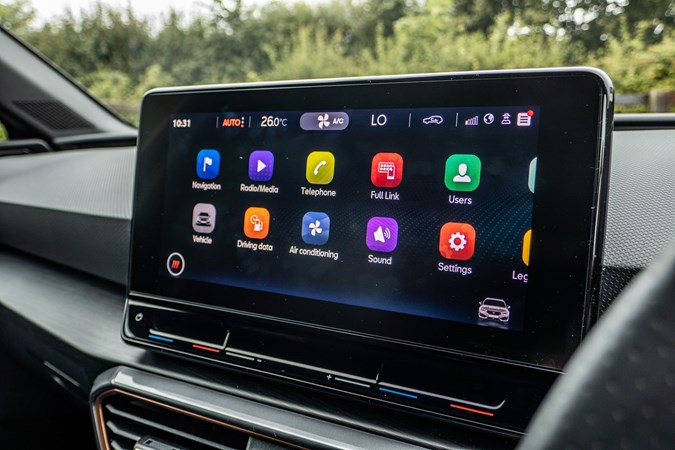
VZ3 spec meanwhile, adds a different wheel design, a wireless phone charger, heated leather seats with electrically adjustable driver’s seat, power lumbar support on the driver side (manual adjustment on passenger side) and an automatic bootlid.
As for what’s under the bonnet, I’ve opted for the straight 2.0-litre turbocharged petrol with 310hp, a seven-speed DSG gearbox and all-wheel drive. A 245hp plug-in hybrid (with a 1.4-litre petrol and 34-mile electric range) is also available.
Controversial interior
In truth, I’m not all that convinced the powertrain has changed that much since I ran the last Cupra estate, and while I am hoping for slightly sharper handling, the driving experience was generally excellent. As was the interior you sat in while piloting the car. Thing is, that latter part has changed quite drastically for this latest model.
Back in 2018, SEAT had resisted the urge to place all ancillary functions in the infotainment system (unlike some manufacturers), instead relying on what I thought was the perfect balance between touchscreen and physical dials. It really was beautifully judged. However, this time around the 10-inch infotainment screen holds the key to almost everything.
Physical dials and buttons have largely been shelved aside from the welcome addition of the starter button and drive mode switch on the steering wheel. That means, say, if you want to increase the temperature, it’s done by toggling touch sensitive pads below the infotainment screen.
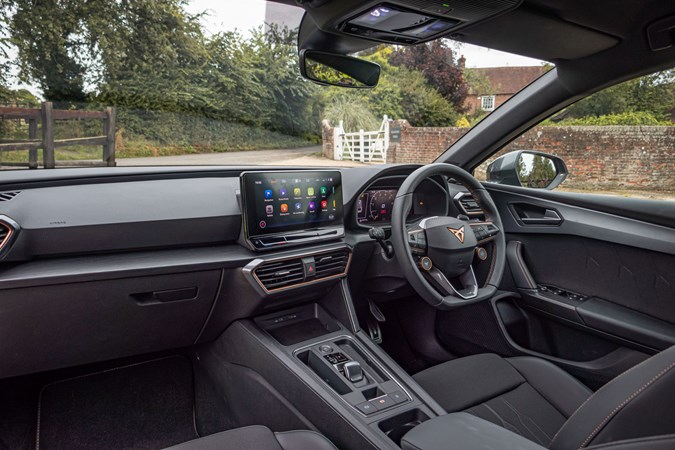
As it stands, I’m having trouble getting the passenger and driver temperatures to sync (although I suspect I’ve got a setting wrong), but something that certainly isn’t right is the way that said touchpads are not illuminated at night. As a result, you can barely see them and certainly can’t tell which one is for hot and which one for cold. You can delve into the infotainment system, but it’s quite a long way around for a simple task.
It’s things like this where I want to discover whether I can get used to them or not. Swapping in and out of test cars on a weekly basis is great, but we can occasionally lose sight of the fact that certain idiosyncrasies (that we may criticise in reviews) aren’t that big a deal once you’re properly used to the car. I’ll report back in the next update..
Until then, I’d love to hear from you. If you’ve got a Cupra Leon Estate or are thinking of buying one, drop me an email at
Starting mileage: 63 miles
Claimed fuel economy: 32.8-34.4mpg
Update 2: Practicality and space
James selflessly gives up his Saturday to help out with a house move and delivers the definitive verdict on the Cupra Leon Estate’s practicality.
OK, you probably saw this coming as soon as the first long-term report of my Cupra Leon estate car went out – but it had to be done. See, us car journalists have an apparent obsession with brimming our test cars with as much stuff as we humanly can, taking a quick pic and then discussing the practicality on offer.
Honestly, if you need something moving, make friends with us when we get a new estate car long termer – we’ll happily do a 100-mile round trip just to go the tip.
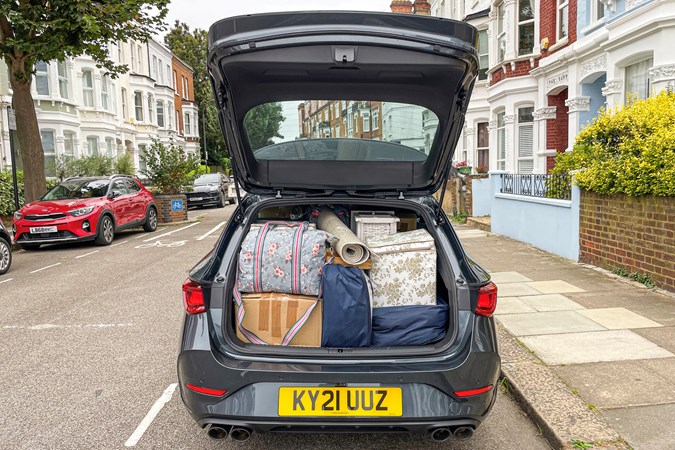
With this in mind, I thought what better way to test out the practicality of my box-fresh long-termer than offering to help my girlfriend move house. After all, this is an estate car and if you weren’t that fussed about boot and passenger space then surely you’d just get the smaller and nimbler hatch version? Well, after a hard day’s work where I managed to better 90% of removal firms by not actually damaging or breaking anything, here’s my verdict of the Cupra’s practicality.
Storage space
Before I get into the actual house move, however, let me tell you what the storage space is like up front for the driver and passenger. This is often overlooked, but the Cupra has a decent-sized glovebox and ample space under the centre armrest, plus the door pockets are large enough to store two bottles of water and a sunglasses case each.
What’s more, two shallow slots either side of the gear-lever make a perfect place to store your keys while the phone holder tray neatly accommodates my iPhone 12.
Rear seat passenger space
Granted, it’s a little dark in the back of the Leon and those front sports seats do feel big when you’re sitting behind them, but otherwise there’s enough room for two average-sized passengers and three at a pinch. A third climate control zone is also a bonus, while Isofix points on the outer rear seats come as standard. I’m yet to experience the rear seats of a Skoda Octavia Estate vRS, but I’m reliably informed that there’s little in it for outright passenger space between the two cars.
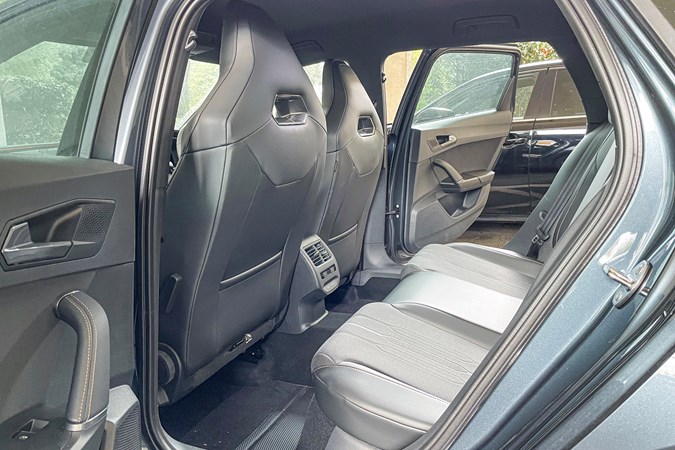
Boot space
The official capacity for the Cupra Leon Estate’s boot is 620 litres with the rear seats in place, just 20 shy of the benchmark wOctavia Estate vRS. Certainly, for my everyday needs it’s been superb, while the cubbyholes on either side have allowed me to securely store bottles of water and other paraphernalia. Perfect for when I’m driving with the verve of a man that’s just spent the entire day moving someone else’s clutter prized belongings and desperately wants to get home and watch Match of the Day.
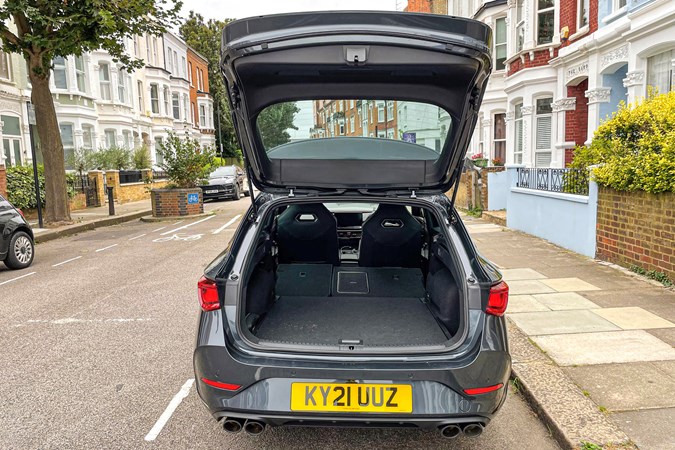
And talking of that, the Cupra did well – accommodating almost 50% of the other half’s possessions in one journey (no mean feat – trust me). The rear seats didn’t fold completely flat (if enough) and the fact they only go down in the 60:40 arrangement (as opposed to the more flexible 40:20:40) wasn’t an issue. It’s also worth noting there is a ski hatch should you need to accommodate four passengers and an extremely long item at the same time.
However, one highlight that I didn’t even consider until afterwards was how the Cupra manages to tread the fine line between premium and utility. Many cars with this level of performance feel too plush or delicate to use as a removal van, with worries about scuffing the leather or getting dirt on the carpet. The Cupra, meanwhile, went from fast estate, to van and back to fast estate again in the blink of an eye, without any worries about how it would weather the treatment.
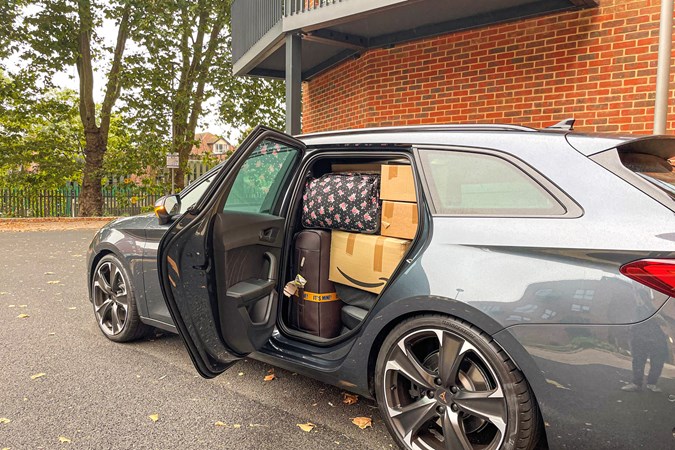
So all-in-all, top marks from me. If you’re wondering whether the performance part compromises the practicality, then don’t. Large sports seats aside, the Cupra Leon Estate feels like it’s nailed this part of the fast wagon brief.
Mileage: 1,623 miles
Average fuel economy: 34.7mpg
Update 3: Buying and running a Cupra Leon Estate
James whips his calculator out and crunches the numbers to discover how much it costs to buy and run the Cupra Leon Estate.
Here’s a question that may have crossed your mind as you’re reading these reports. How much would it actually cost to run a Cupra Leon Estate? Not just the monthly PCP payments, but taking into account the fuel, road tax, servicing and insurance. The final figure, whether it be monthly or yearly, will give you an idea of how the car fits into your budget and whether it’s a realistic ownership proposition.
Well, if said thought had entered your mind then today is your lucky day because I’ve got my calculator out and crunched the numbers to give you the definitive answer.

Cupra Leon Estate PCP deals
Before working out anything else, the cost of buying the car must be considered. Using Cupra’s handy online finance calculator I managed to get a quote for the VZ2 Leon Estate that came in at £572 per month. That’s on a 36-month contract (3.9% APR) with a £5k deposit assuming 10k miles per year. Handily, Cupra will also give you a contribution of £1,500 towards the total price. If you want to buy the car at the end of the deal, the balloon payment works out to £15,277. For more great car finance deals, check out the Parkers Deal Watch page where you’ll find incredible offers on a wide range of cars,
Leon Cupra Estate tax, servicing, insurance and fuel economy
Starting with tax, the first year’s levy is included in the purchase price meaning for the purposes of this calculation we can go straight to the year 2 and 3 cost – £155 a year. Servicing, meanwhile, comes courtesy of the Cupra Care plan and works out at £402 for the three-year duration of the PCP deal.
For the insurance quotation, I’ve reverted to my alter ego, Ken Dennis. He’s a 40-year-old married man living in Peterborough, has been driving for 20 years, has 10 years no-claims bonus, parks his car on the street and uses it for social, domestic and pleasure. The cheapest quote I could find was £402 a year, paid upfront. Finally, fuel consumption works out at £2,079. That may seem a lot, but bear in mind that’s running super unleaded (regular unleaded is compatible, but best avoided) at the inflated price of £1.60 a litre.
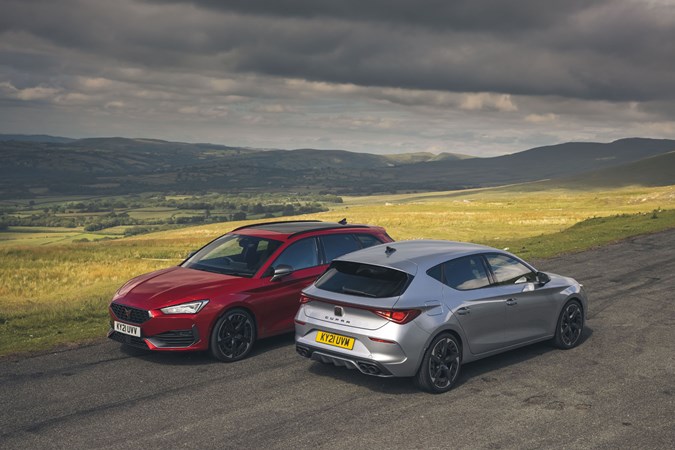
So, what does that all mean? Well, having done some in-depth number crunching, the total cost of buying and running a Cupra Leon Estate over three years is… £48,410. If you were to hand the car back at the end of that three years, this drops to £33,133. Therefore, the average monthly outgoing (excluding the deposit and final balloon payment) works out at £781.
Buying and running a VW Golf R Estate
The obvious thing to do here would be to compare the Leon Estate to its sibling and closest rival, the VW Golf R Estate. However, at the time of writing, said car has been confirmed but prices are yet to be announced for the UK market. So, I’ve had to improvise a little by getting figures for the VW Golf R Hatch. Not quite the same, granted, but I’m going to even things up by comparing it with the Cupra Leon Hatch so that you can get some idea of the kind of difference we’re talking about. Once the Golf R Estate prices are released, I’ll update this article accordingly.
Going through the numbers for the VW, there’s a few things worth noting. First is that the APR rate is 4.9% (Cupra is 3.9%), while the deposit contribution is also £250 less at £1,250. Insurance for the Golf R is slightly cheaper than the Leon Hatch (£512 vs £555) but noticeably more expensive than the Leon Estate.
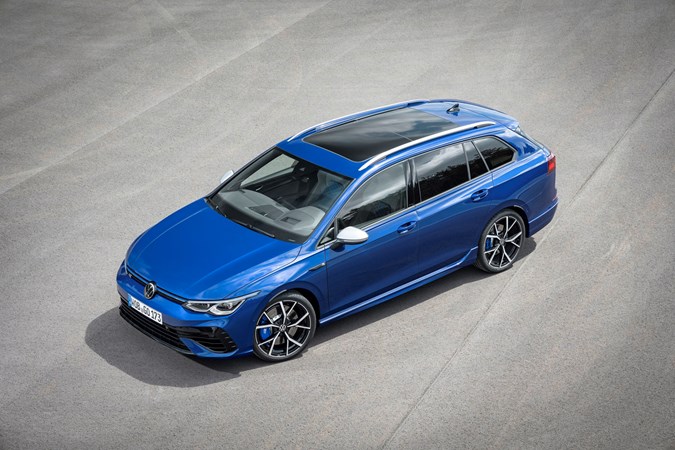
Also, while the two hatches fit into the same car tax category, previous pricing for the Golf R Estate indicate that it this latest model will come in above the £40,000 luxury car threshold. This it will attract a £490 tax in year two and three, versus £155 for the Leon Estate.
Final scores on the doors for the Golf R Hatch are £33,489 to run over three years and hand back, £52,519 to run and keep and an average monthly cost of £791. This versus £30,057 (-£3,432), £45,163 (-£7,356) and £696 (-£95) respectively for the Cupra Leon hatch. Just to reiterate, while these figures are accurate at the time of writing for the Cupra Leon Hatch and Golf R Hatch, they may not translate into the proportional difference between buying and running the equivalent estate versions.
Verdict: Is the Cupra Leon Estate good value for money?
There’s no denying that, for most of us, £781 a month sounds like a lot of cash. Largely because it is. It’s only when you put it into context with the smaller and less practical Golf R hatch that you realise the Cupra Leon Estate does, comparatively, offer solid value for money for what it does.
Remember, this is vehicle that doubles up both as a sports car and everyday family wagon, while offering pretty much everything in-between. Matching what the Cupra offers for similar money is difficult and you’d more than likely have to look in the second-hand market or take a drop in performance with, for example, a Skoda Octavia Estate vRS. Of course, everyone’s situation is different and the above is only intended as guide, so do make sure you’re 100% happy with the monthly outgoings before committing to a personal finance deal.
Tune in next time for my final report on the Cupra Leon Estate and give you the ultimate verdict on this high-performance family estate… In the meantime, don’t hesitate to get in touch via email or socia media – james.dennison@parkers.co.uk, Twitter, Instagram.
** These deals are indicative examples of some packages available as of 24 November 2021, but are subject to change without prior notice. Everyone’s financial circumstances are different and the availability of credit is subject to status. Terms, conditions and exclusions apply. Parkers cannot recommend a deal for you specifically.
Mileage: 3,725 miles
Average fuel economy: 35.2mpg
Update 4: Goodbye
It’s time for James to bid farewell to his Cupra Leon Estate. Question is, would he recommend it?
It’s happened again. I’ve become rather attached to my now departed Cupra Leon Estate long-termer. I may have only had it for a few months, but it’s certainly made an impression and I’ll be sad to see it go. Has it been all plain sailing, though? Read on to find out…
Cupra packs a punch on the road
The first thing I’ve got to say about this car is, well, it’s quick. Properly quick. In the real world, there really isn’t much that’ll outrun it in a straight line or, indeed, in the corners where its all-wheel drive system provides faultless traction. When I’ve needed that all-weather pace and sure-footed handling it’s never let me down, and for a family estate car that kind of thing is crucial.
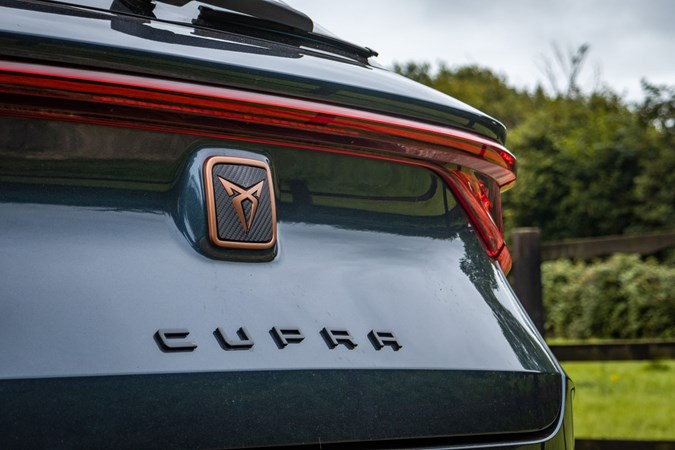
I can confidently say it’s a step-up dynamically from the 2017 SEAT Leon ST Cupra Estate I ran, delivering greater agility and body control, as well as a touch more straight-line speed. In fact, the only way I think the old car outscored it in the driving department was its proper gearlever with a sequential mode. With the newer model, you’re left with a stubby silver lever that – although far smaller – never quite feels right in a fast estate car.
It’s not just a performance car, however. Thankfully the Cupra is extremely easy to drive on the day-to-day grind, something that you’ll no doubt spend most of your time doing. The steering can be set so it’s nice and light, the seven-speed DSG gearbox is smooth, the ride on adaptive dampers is reasonable, plus road and wind noise aren’t too intrusive. It’ll even achieve over 40mpg on a long run. Honestly, this is one of those cars that doesn’t ask you to accept compromises due to the performance it delivers. From a driving point of view, it offers the best of both worlds.
Proper estate car practicality
The primary benefit of getting the estate over the hatch version of the Cupra Leon is of course practicality. Those in the back found themselves blessed with ample knee, leg and headroom, as well as getting their own USB-C points and climate control zone. Fitting three adults across the second row is a squeeze (largely due to the chunky central transmission tunnel), but that’s no different to any of this car’s rivals.
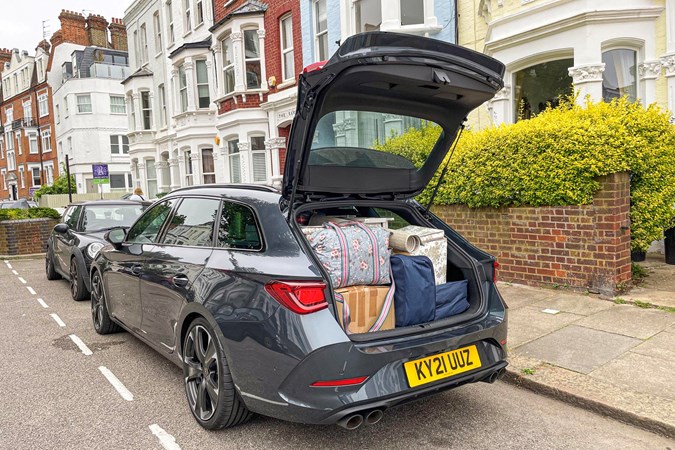
Bootspace proved equally impressive when I was roped in to help my girlfriend move house. Granted, I couldn’t fit all her belongings in (I’d have needed one of those Australian road trains for that), but with the seats folded down the boxy and practical boot took an enormous amount of items. If we’re being fussy the rear seats don’t go down completely flat and it would be nice to have them in a more flexible 40:20:40 folding arrangement, but otherwise I’ve got zero complaints.
One final bonus is the optional foldaway tow bar. Costing £700, it stays hidden out of sight until required. All you have to do is flick a switch in the boot and lock it in place – the work of around four seconds. Very impressive.
Infotainment and technology
To borrow my earlier analogy about plain sailing, this is where myself and the Cupra encountered some rather rough seas. On the face of it, the Cupra’s infotainment system and onboard tech should be excellent – aside from the temperamental sat-nav I certainly can’t remember any issues with the previous generation car. However, my overriding feeling having run this 2021 car is that the infotainment system was rushed.
It was prone to lagging (not ideal when you quickly want to adjust something or switch screens), plus parts of the layout and user-interface didn’t make sense. See the radio shortcuts screen dropping down a line (therefore not showing the majority of shortcut buttons) and the digital dash reverting to the driver assistance display every time you turn the lane assist off. What’s more, the decision not to backlight the hot and cold climate buttons on the dash (meaning you can’t see either at night) completely baffled me.

All of the above isn’t simply a quirk of my particular car either. Having driven several recent products from the VW Group (including the Mk8 Golf) and spoken to colleagues, the past few months simply confirms our suspicions that the infotainment system could be a lot better.
Is it a deal-breaker? For me, no. I’ve learnt to work around the quirks and oddities in a way that I perhaps wouldn’t on a shorter test. Plus, I am impressed by the digital cockpit and the amount of customisation on offer, not to mention its largely logical layout and design. However, given that we’ve gone from a quick and effective infotainment system on the previous generation car, this does feel like a step backwards and one that owners will need to get their head around.
Verdict
So, would I recommend you put your hard earned towards a Cupra Leon Estate? In short, yes. It’s an impressively well-rounded car that offers something a little less obvious than the Skoda Octavia vRS Estate or the upcoming Golf R Estate. True, the Cupra Formentor is an intriguing option, yet at a time when every second new car appears to be an SUV, the estate equivalent is the more exclusive option.
Granted, the infotainment system could and should be better, but it’s an issue that you do eventually get used to, and one that’s not significant enough to spoil the rest of the car. The overall drive is superb, there’s plenty of space, the standard equipment is decent and it’s still pretty exclusive. In short, it feels like it’s equipped for almost anything. Whether you need to fold the back seats down for a raid on Ikea, take your kids to school or embarrass a sports car on a twisty B-road, it has it covered.
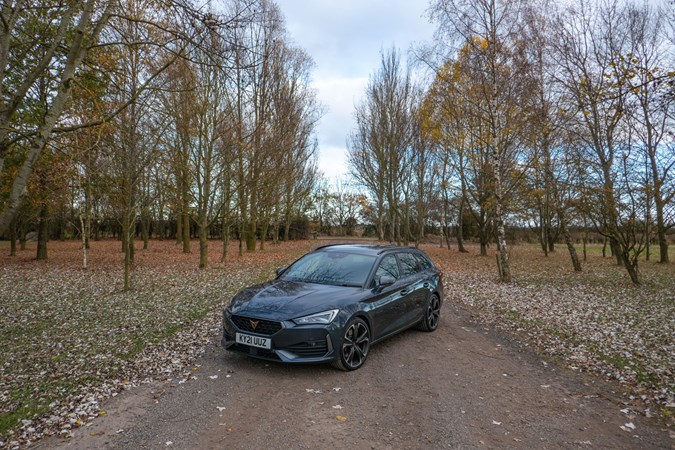
Hopefully you enjoyed this series of long-term reports on the Cupra Leon Estate, and if you have any questions then don’t hesisate to get in touch via email or on social media. Next up for me is an Alfa Romeo Giulia Veloce, so be sure to head over to and take a look for more in-depth Parkers reviews content.
Mileage: 4,998 miles
Average fuel economy: 36.3mpg



